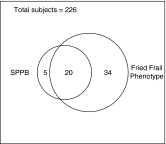Frailty Phenotypes, Disability, and Outcomes in Adult Candidates for Lung Transplantation
- PMID: 26258797
- PMCID: PMC4731703
- DOI: 10.1164/rccm.201506-1150OC
Frailty Phenotypes, Disability, and Outcomes in Adult Candidates for Lung Transplantation
Abstract
Rationale: Frailty is associated with morbidity and mortality in abdominal organ transplantation but has not been examined in lung transplantation.
Objectives: To examine the construct and predictive validity of frailty phenotypes in lung transplant candidates.
Methods: In a multicenter prospective cohort, we measured frailty with the Fried Frailty Phenotype (FFP) and Short Physical Performance Battery (SPPB). We evaluated construct validity through comparisons with conceptually related factors. In a nested case-control study of frail and nonfrail subjects, we measured serum IL-6, tumor necrosis factor receptor 1, insulin-like growth factor I, and leptin. We estimated the association between frailty and disability using the Lung Transplant Valued Life Activities disability scale. We estimated the association between frailty and risk of delisting or death before transplant using multivariate logistic and Cox models, respectively.
Measurements and main results: Of 395 subjects, 354 completed FFP assessments and 262 completed SPPB assessments; 28% were frail by FFP (95% confidence interval [CI], 24-33%) and 10% based on the SPPB (95% CI, 7-14%). By either measure, frailty correlated more strongly with exercise capacity and grip strength than with lung function. Frail subjects tended to have higher plasma IL-6 and tumor necrosis factor receptor 1 and lower insulin-like growth factor I and leptin. Frailty by either measure was associated with greater disability. After adjusting for age, sex, diagnosis, and transplant center, both FFP and SPPB were associated with increased risk of delisting or death before lung transplant. For every 1-point worsening in score, hazard ratios were 1.30 (95% CI, 1.01-1.67) for FFP and 1.53 (95% CI, 1.19-1.59) for SPPB.
Conclusions: Frailty is prevalent among lung transplant candidates and is independently associated with greater disability and an increased risk of delisting or death.
Keywords: biomarker; body composition; disability; frailty; lung transplantation.
Figures



Comment in
-
Allocating Organs for Lung Transplantation. Two Sides of the Coin.Am J Respir Crit Care Med. 2015 Dec 1;192(11):1271-2. doi: 10.1164/rccm.201508-1659ED. Am J Respir Crit Care Med. 2015. PMID: 26623684 No abstract available.
References
-
- Valapour M, Skeans MA, Heubner BM, Smith JM, Schnitzler MA, Hertz MI, Edwards LB, Snyder JJ, Israni AK, Kasiske BL. OPTN/SRTR 2012 Annual Data Report: lung. Am J Transplant. 2014;14:139–165. - PubMed
-
- Yusen RD, Edwards LB, Kucheryavaya AY, Benden C, Dipchand AI, Dobbels F, Goldfarb SB, Levvey BJ, Lund LH, Meiser B, et al. International Society for Heart and Lung Transplantation. The registry of the International Society for Heart and Lung Transplantation: thirty-first adult lung and heart-lung transplant report—2014; focus theme: retransplantation. J Heart Lung Transplant. 2014;33:1009–1024. - PubMed
-
- Lyu DM, Zamora MR. Medical complications of lung transplantation. Proc Am Thorac Soc. 2009;6:101–107. - PubMed
-
- Egan TM, Murray S, Bustami RT, Shearon TH, McCullough KP, Edwards LB, Coke MA, Garrity ER, Sweet SC, Heiney DA, et al. Development of the new lung allocation system in the United States. Am J Transplant. 2006;6:1212–1227. - PubMed
Publication types
MeSH terms
Substances
Grants and funding
- IK2 CX001034/CX/CSRD VA/United States
- HL115354/HL/NHLBI NIH HHS/United States
- R01 HL087115/HL/NHLBI NIH HHS/United States
- R01 HL081619/HL/NHLBI NIH HHS/United States
- HL087115/HL/NHLBI NIH HHS/United States
- K23 HL111115/HL/NHLBI NIH HHS/United States
- HL096845/HL/NHLBI NIH HHS/United States
- K24 HL115354/HL/NHLBI NIH HHS/United States
- UL1 RR024131/RR/NCRR NIH HHS/United States
- K12 HL119997/HL/NHLBI NIH HHS/United States
- R01 HL114626/HL/NHLBI NIH HHS/United States
- UL1 TR000040/TR/NCATS NIH HHS/United States
- R01 HL096845/HL/NHLBI NIH HHS/United States
- HL114626/HL/NHLBI NIH HHS/United States
- K24 HL131937/HL/NHLBI NIH HHS/United States
- K23 HL121406/HL/NHLBI NIH HHS/United States

